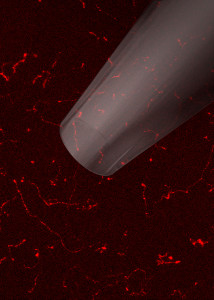Researchers from the Instituto de Neurociencias at the UMH discover how the discomfort from dry eye disease originates
Campus, Elche, Fuente, Investigación, Noticia, Noticia con foto, Front UMH
12 June 2015
A group of researchers from the Instituto de Neurociencias, a mixed center of the Miguel Hernández University of Elche (UMH) and the Spanish National Research Council (CSIC), has a participated in a study on the origin of the symptoms of dry eye disease. The work, which explains the molecular mechanism leading to the discomfort that causes this disease, has been published in the journal Nature Communications.
Dry eye is the most common eye disease in the world, and especially so in older people. It is caused by disorders in the quantity and quality of tears, and leads to continuous eye pain and irritation, increased blinking and altered vision, and can potentially cause blindness. UMH Professor Carlos Belmonte explained that “until now we knew that the nervous system is sensitive to increases in the concentration of salts that in turn causes decreases in the volume of tears of dry eye disease, but we did not know the molecular mechanism responsible for the excitation of these nerves.”
Instituto de Neurociencias researcher Félix Viana added that “we have worked with genetically modified mice to suppress the action of the TRPM8 protein, which is present in the nerve fibers of the eye surface, and we have been able to confirm that, under similar conditions of salt concentrations in tears, our mice blinked less than the mice that had not subjected to this genetic modification.”
“We believe the TRPM8 protein is that responsible for the nerve signals reaching the brains in persons with dry eye and they cause increased blinking and sensation of pain,” concluded Andrés Parra. Currently, he is a postdoctoral researcher at the Max Planck Florida Institute for Neuroscience (USA), and will return to the Instituto de Neurociencias in the coming months.
The work, completed by researchers Carlos Belmonte, Andrés Parra, and Félix Viana, was done in collaboration with the Wolfson Centre for Age-Related Diseases of King’s College London (United Kingdom) and forms part of ongoing research on dry eye at the Sensory transduction and nociception and Ocular neurobiology units of the Instituto de Neurociencias. These units are directed by researchers Félix Viana and Juana Gallar, respectively.
